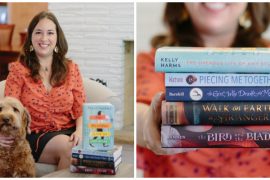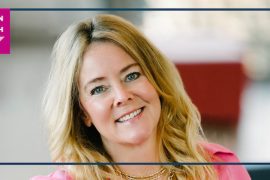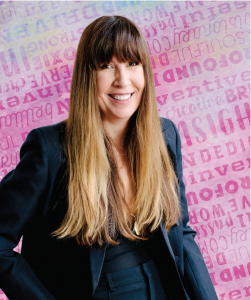By Katie Vaughn | Photography by EP Studio
It’s not an exaggeration to say that social media helped save Larissa Anderson’s life.
Back in 2021, Anderson, founder and principal designer at Haven Design Studio, connected with fellow Madisonian Taryn Pemberton on Instagram. The two exchanged DMs about books before meeting up in real life. As they began sharing more deeply about their lives, Pemberton told Anderson about battling breast cancer in her thirties.
“It felt so distant in my life,” Anderson says of cancer. “I didn’t know anybody who had gone through it — definitely no one younger.”
With Pemberton’s experience on her mind and her 40th birthday approaching, Anderson decided to do a breast self-exam.
“I kind of felt something initially, but just assumed it was dense breast tissue,” she says. After all, she had no family history of breast cancer and was in the best physical shape of her life.
Still, Anderson reached out to a nurse practitioner (NP) who worked with her husband Mark, a family practice doctor at UW Health. A breast cancer survivor herself, she insisted that Anderson come in for a mammogram.
Thinking it would be a routine screen and she’d go on with her day, Anderson showed up for the mammogram. But when the radiologist decided to take extra images, and then called for an ultrasound, she got a sinking feeling in her stomach.
“The BI-RADS rating scale for abnormal mammogram findings is 0-6,” Anderson says. “This was rated a 5, which was a 95% likelihood that it was cancer. My brain turned off; I felt totally numb.”
Anderson returned the following day for a biopsy, and then began the agonizing wait for the results. She and Mark decided to still go on their end-of-summer trip to Door County with their three kids, Dane, Aria and Knox, who were 12, 10 and 8 at the time.
“It was horrible,” she says. “I just cried a lot at night and tried to be normal during the day.”
While on vacation, Anderson received a message on MyChart.
“Mark read it and said, ‘You have cancer,’” she says. “I turned 40 on Aug. 11, and on Aug. 30 I found out I had breast cancer.” They were devastated.
Back in Madison, further testing revealed that Anderson had estrogen-positive stage three breast cancer, with the cancer detected in one breast and a lymph node.
“I learned I was going to have to do chemo, I was going to have to have a mastectomy, I was going to have to
do radiation,” she says. “It just felt so scary at that point. There were so many unknowns. I thought, ‘I have these young kids, I can’t die.’”
Once you receive the official diagnosis of cancer, “everything happens at warp speed,” Anderson says.
She began chemotherapy in September, starting with the toughest chemo medication, the ominously named “red devil,” and continued every two weeks for four months. Each round lasted four to six hours and the toll the drugs took on her body was brutal.
“I had chemo on Wednesdays, and on Saturday it would hit me,” she says. “It was the most fatigued I’ve ever been. I had rashes all over, I lost my hair, and eyelashes and fingernails; I had sores in my mouth. It affected every part of my body.”
After chemotherapy came surgery. Anderson opted to have a double mastectomy with implants. The first surgery removed Anderson’s breast tissue and placed expanders; six months later, she began daily radiation for six weeks. Six months after that, she had a second surgery to swap the expanders for implants. And in June 2022, Anderson started oral chemotherapy and ongoing hormone suppression medication.
“Chemo pushes you into medical menopause,” she says. “It’s changed everything about my body. My joints constantly hurt, I gained 20 pounds in the first three months, I had horrible hot flashes and night sweats. A year into the medication, I’m finally learning to manage all the symptoms.”
In addition to her family, friends and hospital staff, Anderson found comfort and connection in an unlikely source.
“Honestly, the way that I got through it is I started sharing my cancer journey on TikTok,” says Anderson, who uses the handle @larissanoel11. “It’s amazing how that became this big community for me.”
On TikTok, Anderson received support, especially from other young women battling cancer, as well as details about what to expect at appointments and suggestions for remedies to relieve side effects.
And as her journey has played out, Anderson has been able to contribute to the conversation. One topic that’s especially resonated for her is hair loss. “I was so afraid of shaving my head,” she says. “To post this on TikTok and have people say, ‘You’ve got this’ and ‘You are still you’ was huge … it was this massive outpouring of love.”
And as she began experimenting with wigs, she shared both her nervousness and tips along the way, even working with wigs.com to help demystify the process of choosing and wearing hairpieces.
Anderson’s online community has also helped her navigate the concept of survivorship.
“No one really talked about it except on TikTok,” she says. “I talk a lot about it now, that you’re not going to be the person you were [before cancer] but that’s okay.”
Back when she began treatment, Anderson visualized going back to her old life — to her healthy body, happy family and thriving interior design business — just as it was.
“I had to grieve that,” she says. “So much of yourself is taken away.”
She’s also had to balance supporting others while protecting her mental health.
“I have friends who have died or have recurrences,” she says. “It’s so important to let yourself experience fear and grief and anger, but to move through it and not let it control the life you get to have.” But that life includes coexisting with the threat of cancer.
This spring, Anderson discovered a lump in her other breast. Testing rated it a 3, “probably not” cancer, but Anderson felt unsettled. Friends on TikTok urged her to push for a biopsy, which she did. The lump turned out to be a fat necrosis, and Anderson was able to enjoy summer with “a lighter heart” thanks to advocating for herself.
As she moves forward, Anderson feels empowered to use her experience to help others. “I feel like my life purpose now includes advocating for women to take care of themselves,” she says, adding that young women in particular need to take breast cancer seriously.
“Self-exams are the best thing you can do,” she says. “I do it on the first of every month. If you have any history of cancer in your family, push for an earlier mammogram. And if you don’t, make sure it happens at 40.” Women need to talk about cancer, Anderson says, as her friend did with her years ago.
“I found my cancer when I did because Taryn was really open and vulnerable with me,” she says.
And she’s finding her way, forever changed by cancer, but not defined by it.
“People say you don’t have to find the silver lining in cancer but it’s there,” she says. “We are so much more intentional about how we talk to each other and how we spend time together as a family. Cancer will always be part of my story and I’ll always have this awareness of how fleeting life is, but I also have this awareness of the good things — my family, my friends, the sunshine that has intensified because of the hard things.”
How to Support A Loved One
Larissa Anderson shares her favorite ways to care for someone going through a medical journey.
- Be with them. “Offer to sit with them during a treatment. Watch a movie with them on days they can’t get out of bed. Text them memes that will make them laugh.”
- Make or buy meals for their family. “ This one is a huge gift … I was so grateful knowing my family had wonderful meals, even though I couldn’t physically prepare them.”
- Let them vent. “ The cancer journey is so lonely. There are often indignities that no one can really relate to, but it helps to be able to say them out loud to a listening ear.”




